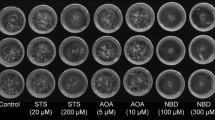Summary
Microscope cultures ofBrassica napus cv. Topas undergo high frequency embryogenesis in vitro; however, the majority of microspore-derived embryos do not develop directly into plants but usually undergo abnormal development including the formation of secondary embryos on the hypocotyls. The present studies show that older embryos or embryos cultured at higher temperature (25° C) were more likely to undergo secondary embryogenesis whereas embryos cultured at 20° C or pretreated at 5° to 10° C for 28 days developed more readily into normal plants. Compared with embryos cultured at 25° C, those cultured at 20° C gave a threefold increase in normal plant production. Pretreatments at cooler temperatures (5° to 10° C) resulted in an additional two-to threefold increase in the recovery of normal plants. Higher osmoticum during pretreatment improved embryo survival at low temperatures but generally inhibited normal plant development. Abscisic acid was ineffective or deleterious.
Similar content being viewed by others
References
Buchheim, J. A.; Colburn, S. M.; Ranch, J. P. Maturation of soybean somatic embryos and the transition to plant development. Plant Physiol. 89:768–775; 1989.
Charne, D. G.; Beversdorf, W. D. Improving microspore culture as a rapeseed breeding tool: the use of auxins and cytokinins in an induction medium. Can. J. Bot. 66:1671–1675; 1988.
Chuong, P. V.; Beversdorf, W. D. High frequency embryogenesis through isolated microspore culture inBrassica napus L. andB. carinata Braun. Plant Sci. 39:219–226; 1985.
Conventry, J.; Kott, L.; Beversdorf, W. D. Manual for microspore culture technique forBrassica napus. Canada: University of Guelph Press; 1988.
Fan, Z. G.; Armstrong, K.; Keller, W. A. Development of microsporesin vitro inBrassica napus L. Protoplasma 147:191–199; 1988.
Gamborg, O. L.; Miller, R. A.; Ojima, K. Nutrient requirements of suspension cultures of soybean root cells. Exp. Cell Res. 50:151–158; 1968.
Gland, A.; Lichter, R.; Schweiger, H. G. Genetic and exogenous factors affecting embryogenesis in isolated microspore cultures ofBrassica napus L. J. Plant Physiol. 132:613–617; 1988.
Keller, W. A.; Arnison, P. G.; Cardy, B. J. Haploids from gametophytic cells—recent developments and future prospects. In: Green, C. E.; Somers, D. A.; Hachett, W. P., et al., eds. Plant Tissue and Cell Culture. New York: Allan R. Liss; 1987:223–241.
Kott, L. S.; Polsoni, L.; Beversdorf, W. D. Cytological aspects of isolated microspore culture ofBrassica napus. Can. J. Bot. 66:1658–1664; 1988.
Lichter, R. Anther culture ofBrassica napus in a liquid medium. Z. Pflanzenphysiol. 103:229–237; 1981.
Lichter, R. Induction of haploid plants from haploid pollen ofBrassica napus. Z. Pflanzenphysiol. 105:427–434; 1982.
Mathias, R. An improvedin vitro culture procedure for embryoids derived from isolated microspores of rape (Brassica napus L.). Plant Breeding 100:320–322; 1988.
Pechan, P. M.; Keller, W. A. Identification of potentially embryogenic microspores inBrassica napus. Physiol. Plant. 74:377–384; 1988.
Polsoni, L.; Kott, L. S.; Beversdorf, W. D. Large scale microspore culture technique for mutation-selection studies inBrassica napus. Can. J. Bot. 66:1681–1685; 1988.
Swanson, E. B.; Coumans, M. P.; Wu, S. C., et al. Efficient isolation of microspores and the production of microspore-derived embryos fromBrassica napus. Plant Cell Rep. 6:94–97; 1987.
Thomas, E.; Hoffman, F.; Potrykus, I., et al. Protoplast regeneration and stem embryogenesis of haploid androgenetic rape. Mol. Gen. Genet. 145:245–247; 1976.
Author information
Authors and Affiliations
Rights and permissions
About this article
Cite this article
Huang, B., Bird, S., Kemble, R. et al. Plant regeneration from microspore-derived embryos ofBrassica Napus: Effect of embryo age, culture temperature, osmotic pressure, and abscisic acid. In Vitro Cell Dev Biol - Plant 27, 28–31 (1991). https://doi.org/10.1007/BF02632058
Received:
Accepted:
Issue Date:
DOI: https://doi.org/10.1007/BF02632058




